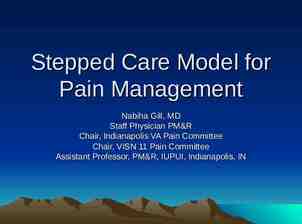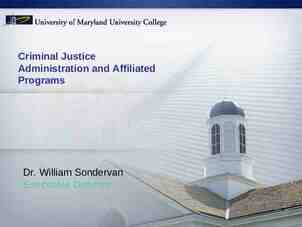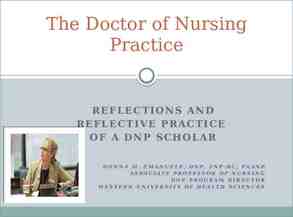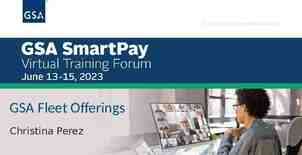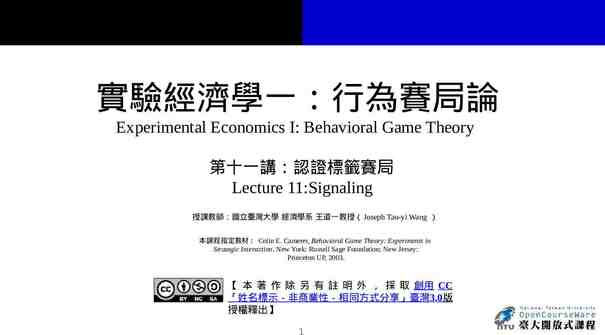Automotive Regulations and Certification Processes: Global
25 Slides1.27 MB

Automotive Regulations and Certification Processes: Global Manufacturers’ Perspective U.S. Automotive Industry Coalition Meeting Andean/Mexico Delegation December 7, 2016

World Without Regulatory Borders We live in an increasingly interrelated and integrated world Global automakers build and sell in markets across the world, promoting trade and investment The ideal is to test once and sell anywhere, maintaining high levels of safety and environmental protection. 2

Automobile Safety & Environmental Impact Governments everywhere are looking for ways to make their roads safer and reduce the impact on the environment associated with motor vehicles Despite significant improvements- According to the United Nation’s World Health Organization, Road traffic injuries are the ninth leading cause of death globally, and the principal cause of death among those aged 15–29 years. 3

Safety Concept Allocation of Responsibility 90% DRIVER INFRASTRUCTURE Training / License Quality / Capacity Age / Fitness / Renewal Repair / Grow OPERATION VEHICLE Limitations / Environment Features / Attributes Conditions / Rules Inspect / Maintain / Modify FAULT SMALL % 4

How to Address Societal Challenges There are two major - equally robust sets of existing motor vehicle safety and environmental regulations US Federal Motor Vehicle Safety Standards (FMVSS) and Environmental Protection Agency (EPA) rules and, UN Economic Commission for Europe (ECE) standards, now referred to as UN regulations under the 1958 Agreement 5

Moving toward Global Technical Regulations (GTRs) In 1998 the UN started to administer a new agreement specifically to develop harmonized Global Technical Requirements (GTRs) for motor vehicles and motor vehicle equipment. UN GTRs provide a predictable regulatory framework for the global automotive industry, consumers and their associations. They do not contain administrative provisions for type approvals and their mutual recognition. The 1998 Agreement has 34 contracting parties (19 if the EU and members are counted as one- in 2015). Both the U.S. and EU, as a single block, (one vote) are contracting parties to the ‘98 Agreement. There are currently 16 GTRs that have been developed under the ‘98 Agreement: o Twelve light duty standards/regulations, o Three motorcycle standards o One off-road emissions standard Under the ‘98 Agreement there are currently no certification or CoP provisions. Those are left up to each contracting party. 6

Why Accept U.S. & ECE/EU Certified Vehicles? While work continues to develop more GTRs, and flaws in the GTR development process are fixed, it is strongly recommended that economies maintain regulatory policy that accepts vehicles for sale in the region that meets both ECE/EU and U.S. regulations. FOUR PRIMARY REASONS: 1. Both are Robust, Long-standing & Tested Both regulatory regimes have been developing safety and environmental regulations for over 40 years. Both systems use technical assessment of real-world data as the basis for regulatory development. Both sets of regulations cover active and passive safety, along with environmental emission control, which lead to state-of-the-art technology to meet their mandated levels of performance. 7

Comparable Performance 2. Both Have Comparable Performance & Outcomes For each comparable FMVSS and ECE auto regulation, some technical differences are certain but that should NOT be the focus. Instead, we should be aware that there are far more similarities in the objectives and outcomes for both regulatory schemes. 8

Comparable Performance Real-world data demonstrates the comparable levels of performance resulting from ECE or U.S. safety and environmental regulations. Europe Various data sets shows that with regards to safety, the EU and US sets of automotive regulations offer the same high-level of performance and outcomes. For auto emissions, both the EU’s “Euro 5”/ECE R83.06 and US’s “Tier 2” have similar requirements. United States 9

High Misalignment Cost 3. Reduces Cost and Increases Efficiency A 2016 study conducted by the U.S. Based Center for Automotive Research (CAR) assessed the costs of having to meet the divergent auto safety regulations entitled: Potential Cost Savings and Additional Benefits of Convergence of Safety Regulations between the United States and the European Union. It concluded that having to meet two different sets of safety standards significantly drive-up costs with no meaningful benefits and the savings realized if full U.S.-EU auto safety regulatory convergence was achieved - totaled 2.3 billion (up to 1,150 per car), but on a global basis, the extra saving rises to as much as 4.2 billion annually. A 2015 study conducted by Peterson Institute for International Economics assessed the costs of having to meet both the U.S. and EU auto regulations (all regulations) entitled: Gains from Harmonizing US and EU Auto Regulations under the Transatlantic Trade and Investment Partnership. The study concludes that regulatory convergence or mutual recognition of regulations between the EU and the U.S. would result in national income gains for both partners together of over 20 billion per year in the long run. 10

Different Marking Requirements Different (Auto glassMarkings example) E / e marks – EU CCC mark – China KC mark – Korea TISI mark – Thailand DOT mark – USA SABS mark – S. Africa JIS mark – Japan AS mark – Australia S mark – NZ BS mark – British Inmetro mark– Brazil US DOT 11

I can’t see anything but I feel safe! And don’t mention lights or mirrors!! US DOT GLOBAL CAR 12

Consumer Benefits 4. Brings Consumer Benefits Increased choices for consumers. Cost savings & efficiencies that can be passed on to consumers. ADVANCED TECHNOLOG Y Proliferation of new technologies- more kinds and more rapidly. 13

Countries that Accept Both FMVSS & UN ECE Examples of countries that accept both: Argentina Australia Bahrain Costa Rica Dominican Republic El Salvador Ecuador Guatemala Honduras Israel Kuwait Mexico Morocco New Zealand Oman Panama Qatar Sub-Sahara Africa (most 25 ) Saudi Arabia South Korea United Arab Emirates Etc 14

TypeApproval Approval & Self-Certification Type Self-Certification It is not just about different standards/regulations, but also about the certification process- specifically- type approval and selfcertification processes. The principle difference between the two is the requirement that for type approval the certification tests are witnessed by a government authority pre-market, and for self-certification these same types of tests are conducted by the vehicle manufacturer, with post-market follow-up verification by a government authority. In both cases data is generated to support the claim that a product meets or exceeds the technical performance requirements of any regulation. 15

Self-Certification Type Approval & Self-Certification Post-Sale Verification The U.S. self-certification system uses a rigorous and robust post-sale verification system, which has helped U.S. regulators uncover defects that went undetected under other approaches. Post-manufacture and sale, NHTSA independently buys vehicles from dealers and tests them at NHTSA’s facilities (44 products per year). This assures that tested vehicles have not been altered, and are the same vehicles marketed to the public. As a result, automakers often build in wider “compliance margins” to be certain that every vehicle coming off the production line will pass NHTSA and EPA’s random post-market tests. NHTSA’s unified /robust post-sale monitoring system allows it to collect and analyze national data to quickly & accurately identify safety & accident trends. These factors are why most of the wider-reaching recalls in recent automotive history originated in the U.S. (e.g., fuel efficiency non-compliance, sudden acceleration, and ignition switch malfunctions, and many more). 16

NHTSA’s Blue Ribbon Letter Program We also recommend that countries accept vehicles that are certified through both type approval and self-certification procedures. In the U.S., automakers test vehicles and certify that they meet FMVSS. The Blue Ribbon Letter Program gives partner countries assurance from NHTSA that automotive products tested and certified by automakers are subject to the highest standard safety compliance process in the U.S., including NHTSA’s robust verification program and enforcement authority. Under the program, NHTSA affirms that the manufacturer self-certifies that its product meets all applicable NHTSA requirements at the time of production. The Blue Ribbon letter is an official, legal document available for products sold in the U.S. market and thus subject to NHTSA’s compliance authority. Firms requesting the Blue Ribbon letters may be required by NHTSA to provide supporting documentation, including test results. 17

Conclusion Automakers offer a diversity of automotive products and technologies, from around the world. As we move toward a globally harmonized vehicle regulatory process through the WP-29 1998 agreement, we recommend facilitating both UNECE and FMVSS/EPA compliant vehicles. A regulatory policy that accepts vehicles for sale in the region that meet both sets of safety and environmental regulations and certification processes offers many benefits: Such a policy will meet the highest safety and environmental standards; Offers state-of-the-art technologies from around the world; Provides consumers with a greater variety of products at a lower cost; Avoids disruption of significant automotive trade. 18

Status: Mexico, Ecuador & Colombia MEXICO: Has served a global model for flexibility on how automakers meet safety and environmental regulations. Mexico accepts vehicles certified to both UNECE, and FMVSS standards/regulations as well as vehicles certified through type approval and selfcertification systems. ECUADOR: Ecuador should be applauded for recently deciding to accept UNECE, FMVSS, CVMSS, and other comparable standards as sufficient to meeting the automotive safety requirements in Ecuador. Ecuador has also agreed to accept the Blue Ribbon Letter to meet the third party validator requirement for vehicles utilizing self-certification. New challenges have emerged, including a call for meeting a higher level of auto emissions (equivalent to Euro-3), and concern that sufficient time be allowed to meet those requirements, and meet certain crash test ratings. COLOMBIA: As Colombia continues to make its planned changes to its auto standards, testing requirements, and certification procedures, we encourage the authorities to look to 19 Ecuador and Mexico as models.

Thank You ? Questions ? 20

BACKUP SLIDES 21

Comparable Crash Avoidance Safety Regulations US regulation FMVSS No. 109 - New Pneumatic Tires FMVSS No. 111 - Rearview Mirrors FMVSS No. 114 - Theft Protection FMVSS No. 118 - Power-Operated Window, Partition, and Roof Panel Systems FMVSS No. 124 - Accelerator Control Systems FMVSS No. 129 - New Non-Pneumatic Tires for Passenger Cars FMVSS No. 135 - Light Vehicle Brake Systems UN-ECE regulation R 30- Pneumatic Tires (Passenger Vehicle) R 54- Pneumatic Tires (Commercial Vehicles ) R 46- Rear View Mirror R 18- Protection Against Unauthorized Use (M,N) R 21-Interior fittings R 89-Speed limitation devices R 30- Pneumatic Tyres (Passenger Vehicle) R 13- Braking System R 13-H- Braking System (Passenger Car) FMVSS No. 138 – Tire Pressure Monitoring System R 64- tires- temp use or spare FMVSS No. 139 – New Pneumatic Radial Tires R 117-tires noise and wet grip FMVSS No. 101 - Controls and Displays R 39-Speedometer R 121- Hand controls, tell-tales and indicators R 35- Foot Controls R 116- Unauthorized use (anti-theft & alarm systems) R 1 ,2, 5, 113 - Asymmetric headlamps R 3- Retro reflecting devices R 4- Rear Registration Plate Lamps R 6- Direction Indicators R 7- Front and Rear Position Lamps, Stop Lamps, End-outline Marker R 8, 20, 31- Halogen Headlamps R 19, 38 - Front and Rear Fog Lamps R 23- Reversing Lamps R 37- Filament Lamps R 45-Headlamp Cleaners R 48- Installation of Lightings R 77- Parking Lamps R 87- Daytime running lamps R 91- Side-marker Lamps R 98, 99- Gas-Discharge Headlamps R 104- Retro Reflective markings (hvy & long veh.) R 112- Headlamp R 119- Cornering lamps R 123- Adaptive Front Lighting System R 128- Light Emitting Diode (LED light sources FMVSS No. 102 - Transmission Shift Lever Sequence, Starter Interlock, and Transmission Braking Effect FMVSS No. 108 - Lamps, Reflective Devices, and Associated Equipment Includes requirements for: Headlamps Reflecting devices Rear license Plate Lamps Direction Indicators Front and Rear Position Lamps Stop Lamps, End-outline Marker Reversing Lamps Installation of Lightings Side-marker Lamps 22

Comparable Crash Worthiness Safety Regulations US regulation UN-ECE regulation FMVSS No. 201 - Occupant Protection in Interior Impact R 21-interior fittings FMVSS No. 202 - Head Restraints (aligned with Global Technical regulation No. 7) R 17- Seats R 25- Head Restraints R 32- Rear End Collision R 12- Steering Mechanism FMVSS No. 203 - Impact Protection for the Driver from the Steering Control System FMVSS No. 205 - Glazing Materials (aligned with Global technical regulation No. 6) R 43- Safety Glazing Material FMVSS No. 206 - Door Locks and Door Retention Components (aligned with Global technical regulation No. 1) R 11- Door Latches and Hinges FMVSS No. 207 - Seating Systems R 17- Seats R 80- Seats (Large Passenger Vehicle) FMVSS No. 208 - Occupant Crash Protection R 33- Head-on Collision R 94- Protection of the Occupants in the Event of Frontal Collision R 16- Seat Belt R 44- Child restraint systems FMVSS No. 209 - Seat Belt Assemblies FMVSS No. 210 - Seat Belt Assembly Anchorages R 14- Safety Belt Anchorages R 16- Safety Belts FMVSS No. 214 - Side Impact Protection R 95- Protection of the Occupants in the Event of Lateral Collision FMVSS No. 225 – Child Restraint Anchorage Systems R 14- Safety Belt Anchorages R 16- Safety Belts R 44- Child restraint systems 23

Comparable Post Crash & Other Safety Regulations Post Crash US regulation Post Crash UN-ECE regulation FMVSS No. 301 - Fuel System Integrity R 34- Fire risks FMVSS No. 303 - - Fuel System Integrity of Compressed Natural Gas Vehicles R 34 – Fire risks R 110- Vehicles using CNG FMVSS No. 304 - Compressed Natural Gas Fuel Container Integrity R 110- Vehicles using CNG FMVSS No. 305 – Electric-powered Vehicle: electrolyte spillage and electrical shock protection R 100- Electric Vehicle battery- crash provisions Other US regulation Other UN-ECE regulation Given the proprietary nature of the vehicle electrical architecture, in the US each vehicle manufacturer conducts their own series of tests for EMC. NHTSA continues to study the need for standardization in this area but no safety need has yet been established R 10- Uniform provisions concerning the approval of vehicles with regard to electromagnetic compatibility This is now a GTR which should be seen as superseding R 26. The US is currently in rulemaking to adopt the GTR. The need for smooth aerodynamic exteriors to meet fuel economy demands have resulted in exterior designs that meet the intent of R 26. R 26-Uniform provisions concerning the approval of vehicles with regard to their external projections Various state laws that mandate a horn on any motor vehicle operating on their roadways, making a de facto federal law. The standard fitment of a horn is also recognized in FMVSS 101 by its required identification in that regulation. R 28 -Uniform provisions concerning the approval of audible warning devices and of motor vehicles with regard to their audible signals Steering equipment as a standard fitment is recognized by the crash protection requirements for controlling steering system intrusion that are contained in FMVSS 204 R 79 - Uniform provisions concerning the approval of vehicles with regard to steering equipment FMVSS 114 specifies requirements for theft protection in the US. NHTSA is studying the effectiveness of immobilizers on reducing auto theft. R 97- Uniform provisions concerning the approval of vehicle alarm systems (VAS) and of motor vehicles with regard to their alarm systems (AS) 24

Current GTRs (2016) Global Technical Regulations (GTR) under the 1998 Agreement (16, with 12 for light-duty vehicles) #1 - Doors locks and door retention components #2 - Measurement procedure for two-wheeled motorcycles equipped with a positive or compression ignition engine with regard to the emission of gaseous pollutants, CO2 emissions and fuel consumption #3 - Motorcycle brake system #4 - Test procedure for compression-ignition engines and positive-ignition engines fuelled with natural gas or liquefied petroleum gas with regard to the emission of pollutants #5 - Technical requirements for on-board diagnostic systems (OBD) for road vehicles #6 - Safety glazing materials for motor vehicles and motor vehicle equipment #7 - Head restraints #8 - Electronic stability control systems #9 - Pedestrian safety #10 - Off-cycle emissions #11 - Test procedure for compression-ignition engines to be installed in agricultural and forestry tractors and in non-road mobile machinery with regard to the emissions of pollutants by the engine #12 – Concerning the location, identification, and operation of motorcycle controls, telltales and indicators Light Duty #13 – Global technical regulation on hydrogen and fuel cell vehicles Motorcycle #14 – Pole Side Impact #15 – Worldwide harmonized Light vehicle Test Procedures (WLTP) Off-road #16 - Tires 25

